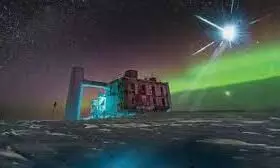
Scientists detect seven "ghost particles" passing through Earth
text_fieldsA breakthrough discovery has been made by astronomers who have detected seven elusive "ghost particles" penetrating through the Earth's surface.
These remarkable observations are by scientists at the IceCube Observatory, deep within the ice of the Antarctic's southern pole, after nearly a decade of monitoring.
Referred to as astrophysical tau neutrinos, these ghost particles serve as messengers between powerful celestial events and Earth. Neutrinos possess zero mass and carry no charge, allowing them to move through space at speeds comparable to that of light, while barely interacting with matter along the way.
Despite their abundance, with nearly 100 trillion neutrinos passing through our bodies every second, their rapid velocity renders them imperceptible to human senses, hence earning them the moniker "ghost particles." Even if one were to construct a detector the size of a human body, it would take roughly a century for a neutrino to interact with it in any detectable manner.
Astrophysical neutrinos, originating from cosmic sources near the outer reaches of the Milky Way, were initially detected by the IceCube Observatory in 2013. Now, with the identification of astrophysical tau neutrinos, scientists have uncovered a new subtype of these enigmatic cosmic messengers.
In a statement, Doug Cowen, co-leader of the project, said, "The detection of seven candidate tau neutrino events in the data, combined with the very low amount of expected background, allows us to claim that it is highly unlikely that backgrounds are conspiring to produce seven tau neutrino imposters." Furthermore, Cowen, also a physics professor at Penn State University, added, "The discovery of astrophysical tau neutrinos also provides a strong confirmation of IceCube's earlier discovery of the diffuse astrophysical neutrino flux."
The IceCube Observatory utilizes digital optical modules (DOMs), strings of golden orbs embedded in the ice, to identify neutrinos as they pass through the Earth. With 5,160 DOMs deployed beneath the Antarctic ice, these detectors await the interaction of neutrinos with the ice's molecules, producing charged particles that emit a telltale blue light, which is then captured by the DOMs.
Although only three strings of DOM detectors were utilized in this recent research, this discovery not only expands the pool of tau neutrino samples but also paves the way for groundbreaking research into neutrino oscillations across three generations for the first time ever.























